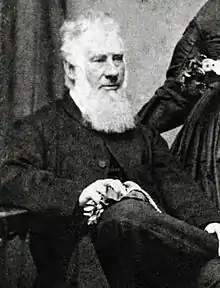Kingston (Province of Canada electoral district)
Kington was an electoral district of the Legislative Assembly of the Parliament of the Province of Canada, in Canada West (now Ontario). It was created in 1841, upon the establishment of the Province of Canada by the union of Upper Canada and Lower Canada. Kingston was represented by one member in the Legislative Assembly. It was abolished in 1867, upon the creation of Canada and the province of Ontario.
| Defunct pre-Confederation electoral district | |
|---|---|
| Legislature | Legislative Assembly of the Province of Canada |
| District created | 1841 |
| District abolished | 1867 |
| First contested | 1841 |
| Last contested | 1863 |
Boundaries
Kingston electoral district was primarily centred on the town of Kingston, Canada West (now Ontario). It was located on the north shore of Lake Ontario, at the beginning of the Saint Lawrence River.
The Union Act, 1840 had merged the two provinces of Upper Canada and Lower Canada into the Province of Canada, with a single Parliament. The separate parliaments of Lower Canada and Upper Canada were abolished.[1] The Union Act provided that the town of Kingston would constitute one electoral district in the Legislative Assembly of the new Parliament,[2] but gave the Governor General of the Province of Canada the power to draw the boundaries for the electoral district.[3]
The first Governor General of the Province of Canada, Lord Sydenham, issued a proclamation shortly after the formation of the Province of Canada in early 1841, establishing the boundaries for the electoral district:
Members of the Legislative Assembly
Kingston was represented by one member in the Legislative Assembly.[2] The following were the members for Kingston.
| Parliament | Years | Member[5] | Party[6] | |
|---|---|---|---|---|
| 1st Parliament 1841–1844 |
Anthony Manahan[note 1] | Reformer | ||
| 1841–1844 | Samuel Bealey Harrison[note 2] |  |
Reformer | |
Abolition
The electoral district was abolished on July 1, 1867, when the British North America Act, 1867 came into force, creating Canada and splitting the Province of Canada into Quebec and Ontario.[9] It was succeeded by electoral districts of the same name in the House of Commons of Canada[10] and the Legislative Assembly of Ontario.[11]
References
- Union Act, 1840, 3 & 4 Vict. (UK), c. 35, s. 2.
- Union Act, 1840, s. 17.
- Union Act, 1840, s. 21.
- Proclamation, Governor General Lord Sydenham, February 27, 1841. Reproduced in the Journal of the Legislative Council of the Province of Canada, First Parliament of the Province of Canada, First Session, 1841, pp. ix–xi.
- J.O. Côté, Political Appointments and Elections in the Province of Canada, 1841 to 1860, (Quebec: St. Michel and Darveau, 1860), pp. 43-58.
- For party affiliations, see Paul G. Cornell, Alignment of Political Groups in Canada, 1841-67 (Toronto: University of Toronto Press, 1962; reprinted in paperback 2015), pp. 93-111.
- Côté, Political Appointments and Elections, p. 59, note (15).
- Côté, Political Appointments and Elections, p. 59, note (14).
- British North America Act, 1867 (now the Constitution Act, 1867), s. 6.
- Constitution Act, 1867, s. 40, para. 2
- Constitution Act, 1867, s. 70.
![]()